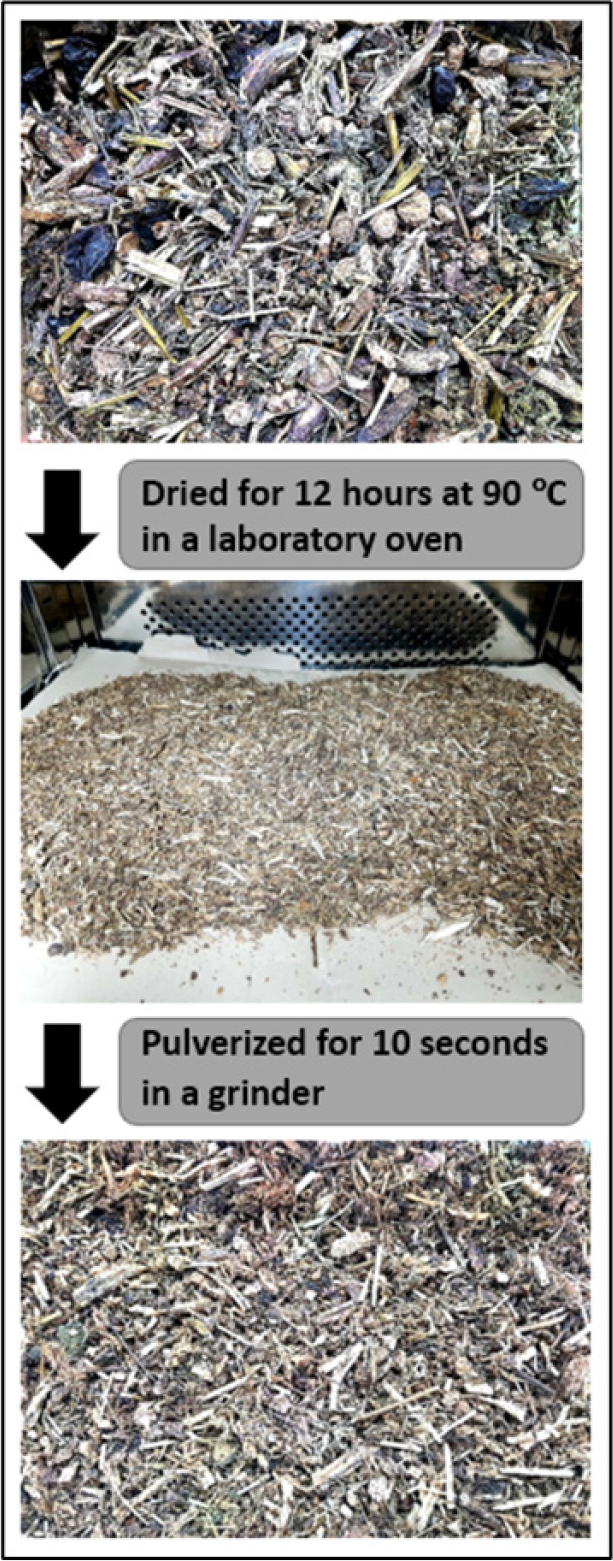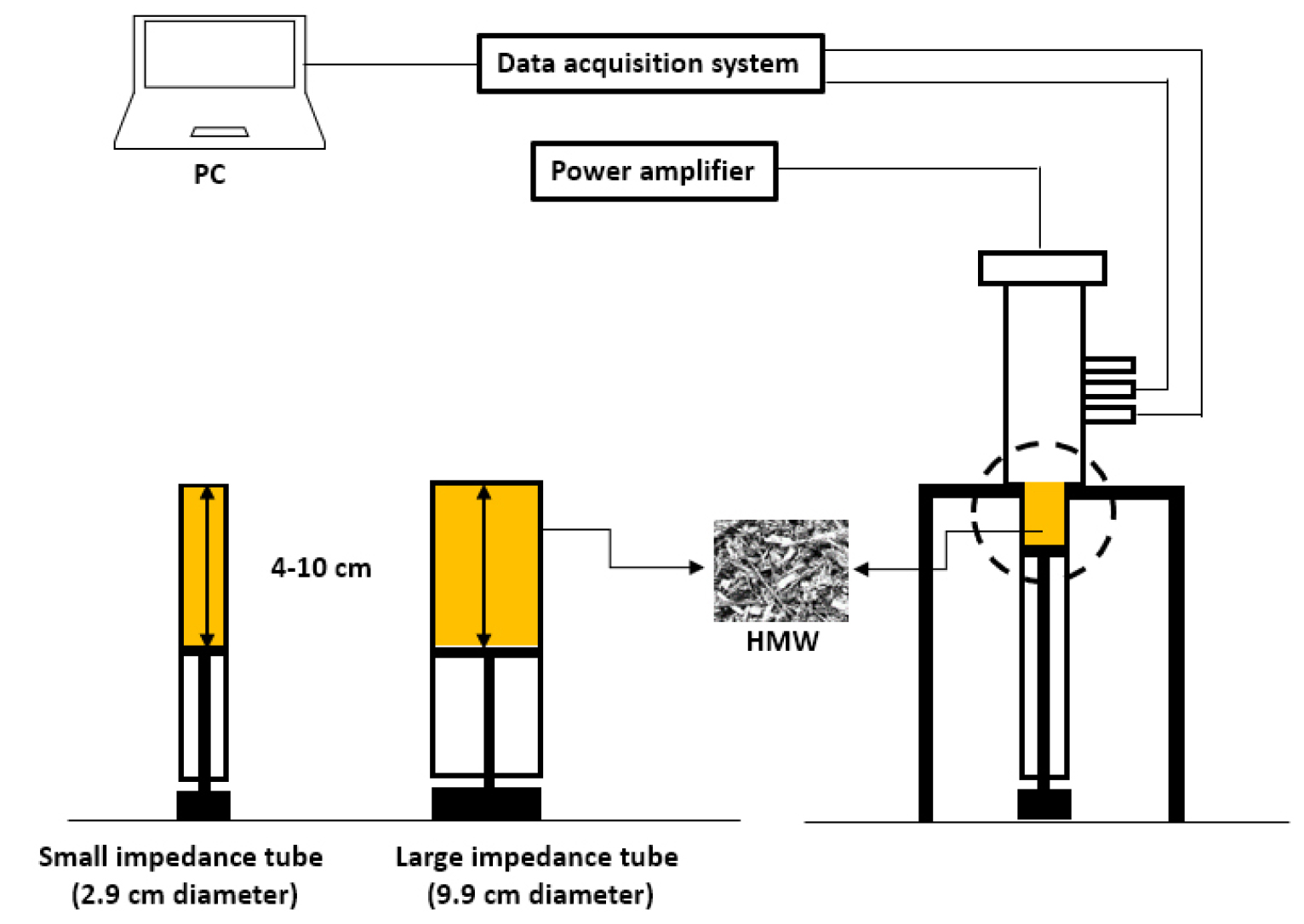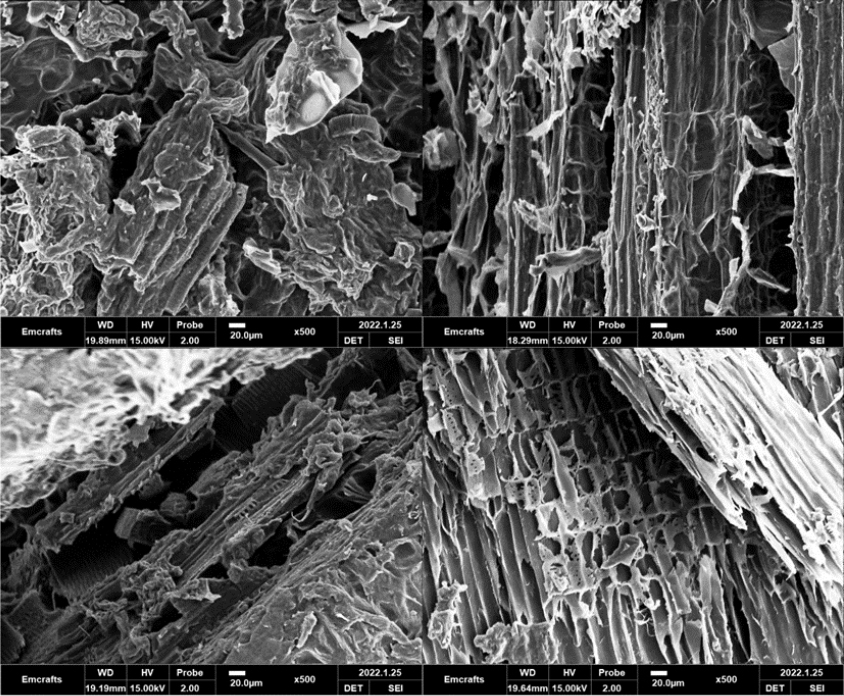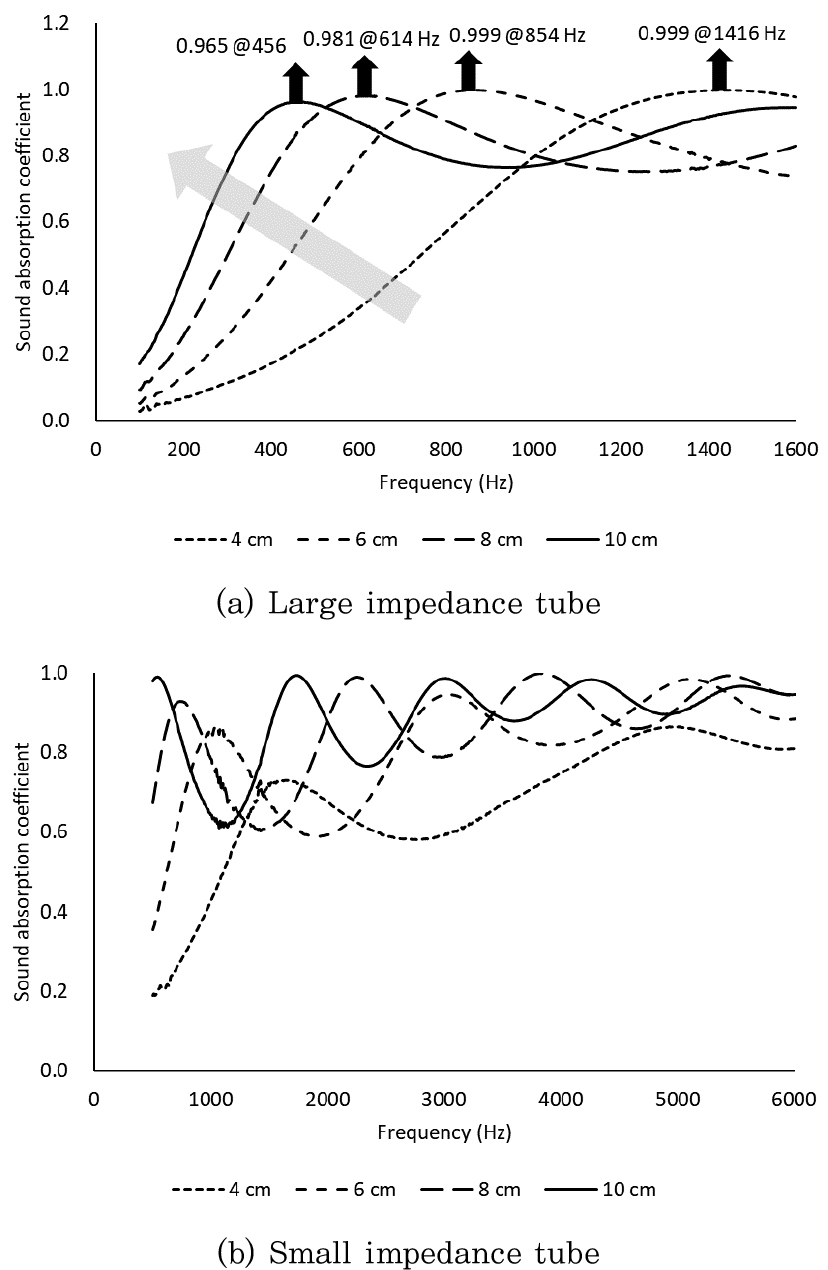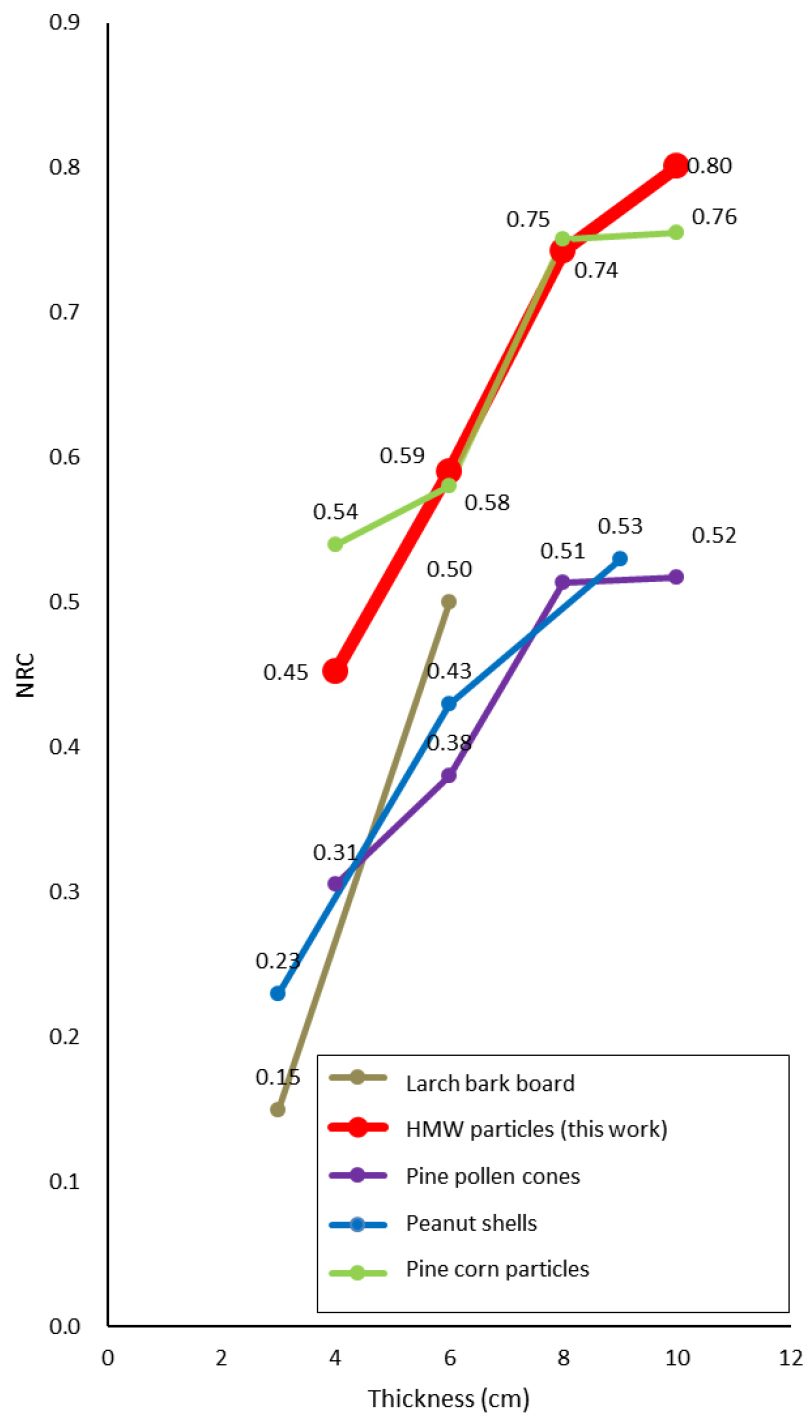1. Introduction
2. Materials and Methods
2.1 Sample preparation
2.2 Method
3. Results and Discussion
3.1 SEM images
3.2 Sound absorption performance
4. Conclusions
1. Introduction
Noise pollution is today a significant concern globally, as is other forms of environmental degradation like air, soil, and water pollution.1,2,3) A number of studies have reported that noise pollution causes mental illness and heart disease in humans.4,5)Therefore, steps to reduce noise transmission are essential components of every city building.
Sound-absorbing materials are the most passive means of reducing the amount of noise transmitted through a building. These sound-absorbing materials are usually made of plastic fibers or urethane foam. These materials are low cost and reduce noise pollution relatively well.6) Environmental pollution caused by plastic is simultaneously emerging as one of the biggest problems of the 21st century.7) More than six billion tons of plastic waste are estimated to have been generated between 1950 and 2015. Only about 9% of plastic waste has been recycled, while 12% has been incinerated and 79% has been landfilled.8)
Recently, the amount of plastic waste has been increasing exponentially due to an increase in the amount of disposable plastic associated with COVID-19.9) The biggest problem with plastic waste is that it is not biodegradable. Plastic wastes migrate and pollute the environment across the Earth, usually for hundreds or even thousands of years.10) In addition, the incineration and production of plastics has a significant long-term impact on the amount of carbon dioxide in the Earth's atmosphere. The only way to reduce the harm caused by plastics is to reduce the amount that is produced,11) while relying more heavily on wood products and agricultural by-products that store carbon dioxide.12,13,14,15,16)
A number of studies have suggested the use of eco-friendly materials as sound-absorbers, including rice straw,17) rice hull,18) corn husk,19) and coir fiber.20) Solid wood, wood-based materials,21,22,23,24,25,26,27) and forest by-products28,29,30) are also known to have a sound- absorbing effect. These have already been reviewed as potential eco-friendly sound-absorbing materials.
This study focused on the use of herbal medicine waste as an environmentally friendly sound- absorbing material. According to the NIKOM (National Institute for Korean Medicine Development), in 2019 the Korean herbal medicine market in 2017 was estimated to be 293.9 billion Korean won (250 million USD).31) The by-products of herbal medicines are almost always either discarded or used as fertilizers.32,33) Xin et al.34) reported that torrefied herbal medicine waste could be used as solid fuel, while Wang et al.35) reported that herbal medicine waste, Flueggea suffruticosa modified by zinc chloride (Zn-BC), could be used biochar. Jouyandeh et al.36) reported that green resources such as amino acids, organic acids, and sugars could be extracted from biowaste. Although various suggestions have been made for alternative uses of herbal medicine wastes (HMW), few studies have examined it as an eco-friendly sound- absorbing material. This study aims to investigate the sound absorption characteristics of HMW.
2. Materials and Methods
2.1 Sample preparation
Fig. 1 shows the sample of HMW as it was prepared for use in this study. The HMW was supplied by Hanulmaum Co., Ltd., Incheon, Republic of Korea. The main components of HMW are astragalus, rehmannia root, ophiopogon, cnidium, bellflower root, Chinese angelica, licorice root, gardenia, eucommia bark, and apricot seed. In addition to this, various herbal medicines were used. All of the HMWs used in this study were plant-derived medicines, and animal-derived medicines were not included.
HMW was in a wet state from which medical substances were extracted. They were dried for 12 hours at 90℃ in a laboratory oven. They were then pulverized in a grinder for 10 seconds to form 15 mm particles. These were placed in a laboratory at 15-20℃ and a humidity of 35-50% for two weeks. One hundred grams of HMW was then placed in an oven and dried at 105℃ to evaluate the moisture content (MC). Around day 3, their weight was 91.10 g, and the MC of the HMW was 9.1%.
2.2 Method
2.2.1 SEM (Scanning Electron Microscopy) image analysis
We observed the HMW particles using a SEM (Genesis-1000, Emcraft, Korea). Samples were dried in an oven at 40℃ for 12℃ to remove moisture. They were gold-coated using an ion coater and observed at 500x using 15.00 kV power.
2.2.2 Sound absorption capability of HMW particles
Fig. 2 is a schematic diagram of sound absorption coefficient measurement system used in this study. The sound absorption capability of HMW was examined using an impedance tube (type 4206, Brüel & Kjr, Denmark). The HMW was loaded to a height of 4 to 10 cm in a large impedance tube (99 mm diameter) and a small impedance tube (29 mm diameter).
The sound absorption coefficient was determined after the impedance tube was mounted vertically to prevent the sample from flowing down. The absorption coefficient was measured by a large impedance tube in the frequency range of 50-1600 Hz, while the 50-6400 Hz range was measured by a small impedance tube. The sound absorption coefficient is given as a value between 0 (reflects all sound waves) and 1 (absorbs all sound waves).
This study calculated the NRC (noise reduction coefficient) and the average of the sound absorption coefficient depending on the frequency section (250,500,1000 and 2000 Hz). In addition, the average sound absorption coefficients were calculated at the 250-500, 500-1000, 1000-2000, 2000-6400 Hz frequency sections. The sound absorption coefficient at frequency 50-1000 Hz was taken from the value of the large impedance tube, and the sound absorption coefficient above 1000 Hz was taken from the value of the small impedance tube.
Sound absorption coefficients were measured at an atmospheric pressure of 1015 hPa, a temperature of 18.6℃, and a relative humidity of 46%. The velocity of sound was 342.4 m/s, the density of the air was 1.2 kg/m3, and the characteristic impedance of the air was 414.3 Pa/(m/s).
3. Results and Discussion
3.1 SEM images
Fig. 3 shows SEM images of HMW formed from dozens of medicinal plants and trees. Their shape was very irregular and porous. These structures are considered to be advantageous, as they help absorb sound.
3.2 Sound absorption performance
Fig. 4 shows the absorption coefficient curve. The sound absorption curve results through the large impedance tube (Fig. 4(a)) show that the sound absorption coefficient at low frequencies increases as the filling height of HMW rises. In particular, the frequency of maximum sound absorption was 1,416 Hz when the tube was 4 cm full. However, the frequency was shifted to 456 Hz at 10 cm filling height. As the thickness of the sound-absorbing material increases, the sound-absorbing property at low frequencies improves. This characteristic is commonly observed in granular and porous sound-absorbing materials.3)
With respect to the sound absorption curve results obtained through the small impedance tube (Fig. 4(b)), as the filling height rises, the number of sound absorption peaks increases. At 4 cm filling height, 2 sound absorption peaks can be observed, but at 10 cm filling height, 5 sound absorption peaks are observed. In short, sound absorption performance improves as the thickness increases.
Table 1 depicts NRC and the average sound absorption coefficient at the 250-500, 500-1000, 1,000-2000, 2,000-6,400 Hz frequency sections. As the filling height of HMW increases, the average sound absorption coefficient did as well. Based on these results, the NRC was also 0.452 for 4 cm filling height, 0.590 for a 6 cm filling height, 0.743 for an 8 cm filling height, and 0.801 for a 10 cm filling height.
Table 1.
Average sound absorption coefficient at each frequency range and NRC of HMW
According to KS F 3503 (“Sound-absorbing material”) sound absorbing material are classified by the NRC into four grades (0.3M: NRC 0.21-0.40, 0.5M: 0.41-0.60, 0.7M: 0.61-0.80, 0.9M: above 0.81). The sound absorption grade of HMW was 0.5M grade for 4 cm and 6 cm filling heights, and 0.7M grade for 8 cm and 10 cm filling heights.
As shown in Fig. 5, we compared the sound absorption characteristics of HMW with the eco-friendly sound absorption materials (pine pollen cones,30) peanut shells,37) larch bark board,38) and pine cone particles39)) in previous studies. The sound absorption characteristics of HMW showed a superior performance compared to other eco-friendly sound absorption materials. This result suggests the possibility that HMW can be considered as a candidate material for eco-friendly sound absorption materials.
This study investigated the sound absorption effect of pure HMW. The sound absorption performance of HMW may vary depending on factors such as the type, mixing method, and classification of raw materials. Therefore, the results of this study have limitations in that the sound absorption characteristics of HMW cannot be fully expressed. The sound-absorbing performance of granular materials also varies depending on the size and packing density of the particles.3) In future studies, we will classify HMW based on particle size and investigate its sound absorption characteristics by varying the packing density. Additionally, it is necessary to establish a model formula that can predict the sound absorption performance of HMW materials using these variables. In order to commercialize HMW sound- absorbing materials, they can be developed into various types such as mat-type materials wrapped with HMW non-woven fabric filled with a specific particle size and pressure, and a combination of HMW and sheets.
Prior to the use of this material in buildings, it will be necessary to first remove the unique herbal medicine odor of HMW. However, even if there is a peculiar smell associated with herbal medicines, this has not prevented their use in oriental medicine clinics, herbal medicine rooms, and traditional tea cafes. Although there are many limitations, it was confirmed through this study that HMW is valuable as an eco-friendly sound absorption material.
4. Conclusions
There have been various proposals for alternative uses of Chinese medicine waste (HMW), such as solid fuels and biochar, but few studies have investigated them as eco-friendly sound-absorbing materials. In this study the sound absorption performance of HMW was investigated. Sound absorption performance improved as the filling height of HMW was increased. The sound absorption grade of HMW was determined to be 0.5M grade for 4 cm (NRC: 0.452) and 6 cm filling height (0.590), and 0.7M grade for 8 cm (0.743) and 10 cm (0.801) filling height based on the KS F 3503. The determined sound absorbing properties of the tested HMW confirmed their potential use as an eco-friendly sound-absorbing material.



